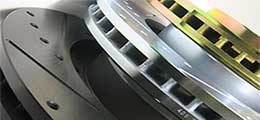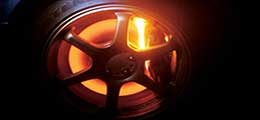Brake rotors and brake pads slow or stop your car through the use of friction. But, did you know that there are two different friction mechanisms at which brakes operate? If not, no need to worry. This article will tell you what these two friction mechanisms are and why it will prove useful for you to know.
So, what are the two friction mechansims you say? The answer is abrasive and adherent friction. Abrasive friction and adherent friction are the two ways your brakes absorb and handle heat when stopping. While all brakes display a bit of both mechanisms, certain vehicles might utilize one over the other.
Abrasive friction is the mechanism by which the energy of motion is transferred to thermal energy through the breaking of chemical bonds of the brake pads and the brake rotors. To help understand what this actually means, lets use an analogy. You can think of the brake rotors and brake pads as your hands. If you rub your hands together, this creates resistance and what you are also doing is breaking off or shedding skin cells. In abrasive friction, the brake rotors and brake pads rub together and pull each other apart, creating brake dust. This particular mechanism is largely utilized by European vehicles and provides for high braking performance, but comes at the expense of high brake pad and rotor wear. This means that lots of dust is to be expected within this friction mechanism. Also, the rotor is typically a softer material than the brake pads which are usually made of a semi-metallic compound. Many owners of European vehicles are often surprised by the short life of their brake pads and rotors, now you know why!
Adherent friction is the mechanism by which a thin layer of the brake pad material is transferred onto the rotor surface. This transfer layer and brake pad surface forms a bond and becomes sticky as the rotors pass between the brake pads. Adherent friction relies on the surface properties of the brake pad and transfer layer, which change with temperature. The bond continually forms and breaks apart, all while absorbing energy in the process. The rotor wears at a slower rate because it is protected by the brake pad transfer layer. The brake pads will wear enough to maintain an even transfer layer of its material onto the rotor. With this, it is easy to see why this type of friction mechanism is ideal for everyday, street use. Adherent friction also loses its effectiveness at higher temperatures, which is why this type of mechanism is not ideal for high performance. Domestic and Asian vehicles primarily uses this type of friction mechanism and the brake pads are typically a ceramic formula while the rotor is a hard cast iron. Unlike abrasive friction, no real material is being lost in adherent friction; therefore there is less brake dust.
Modern technology has allowed brake part manufacturers to create brake pad formulas that balance both of these mechanisms, thereby allowing optimal performance. European vehicles typically employ more of an abrasive friction mechanism by using a softer, high carbon rotor with a semi-metallic brake pad. Asian and Domestic vehicles typically employ an adherent friction mechanism using a hard, cast iron rotor with a ceramic brake pad. In the end, each has its own benefits and the ideal combination of brake pads and rotors will depend on what you want out of your brakes (e.g. less noise, less dust, better stopping performance etc.).







